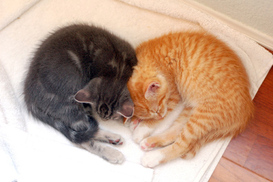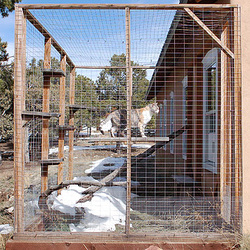Cat Resource Library
 2 kittens are better than 1 ............. Photo copyrighted. 2 kittens are better than 1 ............. Photo copyrighted.
Please see our CAT SPAY & NEUTER section for FREE spay-neuter resources.
Please click on the links listed in blue below: Full Resource Library from Best Friends Animal Society Full Article List of Resources for Cats by Best Friends Animal Society Welcoming Home a New Cat Prevent Problems from Day One Keeping Your Cat Healthy Introducing a New Cat Why Kittens Should be Adopted in Pairs Pets' Dental Health How to Trim Your Cat's Nails/Claws Cat Inappropriate Elimination Getting kitty to use the litter box. Cat Stopped Using the Litter Box? Protect Your Pet During Winter and Cold Weather Reference Guide for Cat & Kitten Foster Care Volunteers Reference Guide for Kitten Foster Care Volunteers If you prefer, contact Planned Pethood Taos for further cat & kitten fostering tips. How to Find Homes for Homeless Pets Finding a New Home for a Pet This article is for re-homing your cat. CAT HEALTH
Common Illnesses in Cats Feline Viruses Feline FIV FAQs answered by Best Friends Animal Society about the Feline Immunodeficiency Virus. Note: Our Planned Pethood Taos founder, a Ph.D. in biology, has read various scientific articles on FIV and based upon sound conclusions from well-designed experiments, in her scientific opinion, it is unlikely a mom cat would transfer FIV to her kittens in utero or via her milk. Reference articles: No Evidence of Vertical Transmission of Naturally Acquired Feline Immunodeficiency Virus Infection. Protection of Neonatal Kittens against Feline Immunodeficiency Virus Infection with Passive Maternal Antiviral Antibodies. Feline FeLV FAQs answered by Best Friends Animal Society about the Feline Leukemia Virus. FIP Feline Infectious Peritonitis FIP does have a treatment to cure this virus in most cases. The curative drug is expensive since it is more difficult to purchase due to that it has not been licensed for commercial use. FIP Slayer is a good website for information about FIP and treating it. Ringworm Ringworm Information from the Koret Shelter Medicine Program Ringworm is a fungus related to athlete’s foot; it’s not actually a worm. Signs & Symptoms: Irregularly shaped areas of fur loss; the skin of the areas will usually appear rough and scaly Treatment: Veterinary care, including an injection and/or topical treatment Transmission: Very contagious to other dogs, cats and people, but usually requires direct contact with the infected animal Ringworm Treatment in a Nutshell |
|
